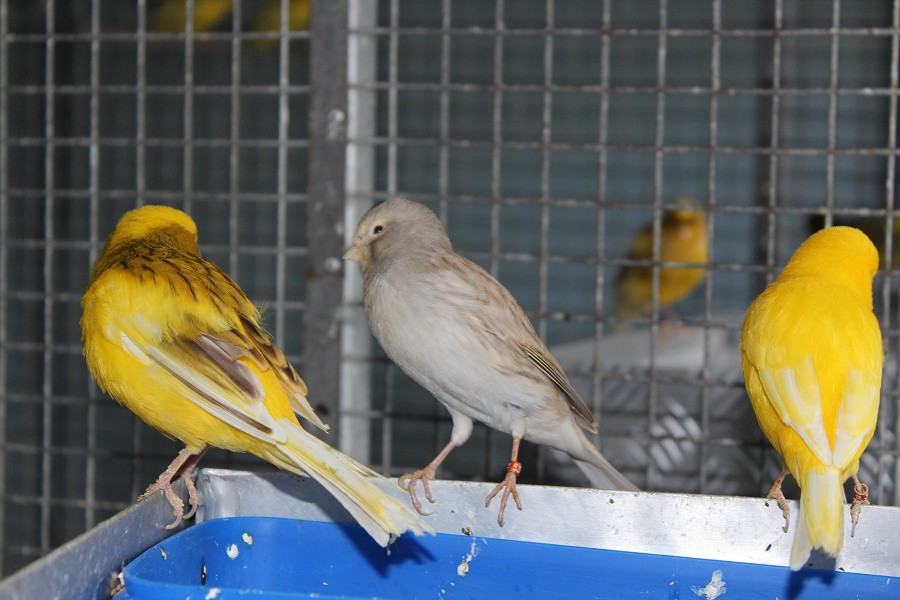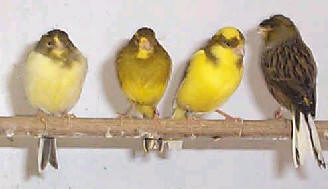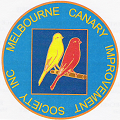
COMMON AILMENTS

COMMON AILMENTS
By Dr Colin Walker
The following is a short list of some of the common problems seen in canaries. It should be always remembered that management or environmental flaws weaken the birds, predisposing them to disease. The provision of clean, dry, draught free accommodation which is not overcrowded, together with good nutrition will do much to decrease the incidence of disease.
| Nestling problem | DISEASE | FURTHER SIGNS THAT SUGGEST THIS PROBLEM | WHAT THE VET WILL NEED TO REACH A DIAGNOSIS | TREATMENT |
|---|---|---|---|---|
| Inside of nest stained with yellow diarrhoea of nestling, youngsters stunted, increased death rate first few days of life. | E. coli diarrhoea | Droppings, microscopic examination, staining and/or culture | Antibiotics. Neomycin. Sulpha AVS in water and soft foods (egg and biscuit canary starter) | |
| Pale, weak youngsters, hen can be found dead in nest | Blood sucking mites | Crusty pinpoint feeding points visible, particularly under wings | Recently dead or unwell nestlings | Moxidectin. Spray cages with Permethrin prior to breeding |
| Nestlings dying, 10-20 days of age, many youngsters affected and dying | Circo virus | Black spot visible in abdomen, which is an enlarged gall bladder | Sick or recently dead youngster for autopsy, tissue collection and histology | Management – Break in breeding, thorough clean of aviary, identify carrier birds |
| Juvenile less than I year of age | ||||
| Generally unwell and dying birds | Atoxplasma, ( a type of coccidian) | Birds usually 2-9 months, high mortality ( up to 80%, blue spot (swollen liver) visible through abdomen. | A sick or recently dead bird for autopsy. Parasite eggs occasionally found in droppings. | Sulfachlor pyrazine reduces but does not eliminate egg shedding. Given for 5 days per week until birds are well. |
| Any Age | ||||
| Main symptom respiratory distress | Pox | Crusty wart-like lesions on non-feathered part of body and/or yellow plaques inside mouth. Difficulty in breathing, high mortality rate. | Appearance often diagnostic. Autopsy and histology. | Management. Separate birds, control insects, treat secondary diseases. |
| Blood sucking mites. | Pale and lethargic. Crusty pinpoint feeding sites visible, particularly under wings | Examination of an unwell bird, or a recently dead bird. | Moxidectin. Spray cages with Permetherin | |
| Air Sac Mites | Loss of condition, cough, sneeze, nasal discharge, unable to sing, response to treatment | Moxidectin | ||
| Trichomoniasis (canker) a flagellate | Weight loss, regurtation, dried saliva around beak | Crop flush from live bird | Tubosole, Flagyl | |
| Bacterial infection, e.g. Enterococcus faecal is | Red watery eyes, nasal discharge | Live bird for bacterial culture | Antibiotics, review hygiene. | |
| Main symptom diarrhoea and weight loss | Coccidiosis | Huddled, fluffed and lethargic | Droppings collected from bird in late afternoon | Baycox (3 mill/1L) for 48 hours. Protein supplements (sprouted seed, seeding grasses, soft foods) |
| Mega bacteria | Fluffed and under weight | Droppings, Autopsy of recently dead bird if available | ||
| Salmonella (a bacteria) | More prevalent in wet times of year, outside aviary, low hygiene, exposure to mice or wild bird droppings. | Autopsy and culture. Pooled dropping samples, checked 3-6 weeks after therapy to check success. Canaries do not become carriers of Salmonella. (common in other birds) | Antibiotics, Usually Baytrill. Provision of chopped greens and soft food will help prevent dehydration, multivitamins in water, hygiene. | |
| Yesinia (a bacteria) | As above | Autopsy and culture | As above | |
| Other bacteria, e.g. E.Coli | Some birds may have an infection elsewhere, e.g. in eyes or sinus | As above | As above | |
| Chlamydia | Often also have conjunctivitis and nasal discharge | Throat swab or cloacae swab or autopsy. | Dopxycyline (Doxyvet 1tsp/2L), Baytril (1 drop twice daily per bird or 10ml/1L of drinking water. | |
| Sudden death | ||||
| Toxic exposure | May have salivation, diarrohoea, difficulty in breathing. | Detailed history | ||
| Starvation | Blood in droppings, some one else looked after birds. | |||
| Miscellaneous | Scaly face, Knemicoptes mite infection | Crust lesions on face and legs | Appearance often diagnostic. Microscopic examination of crusts | Moxidectin (2mg/m’l to affected birds twice! at 3 week intervals) |
 Melbourne Canary Improvement Society
Melbourne Canary Improvement Society